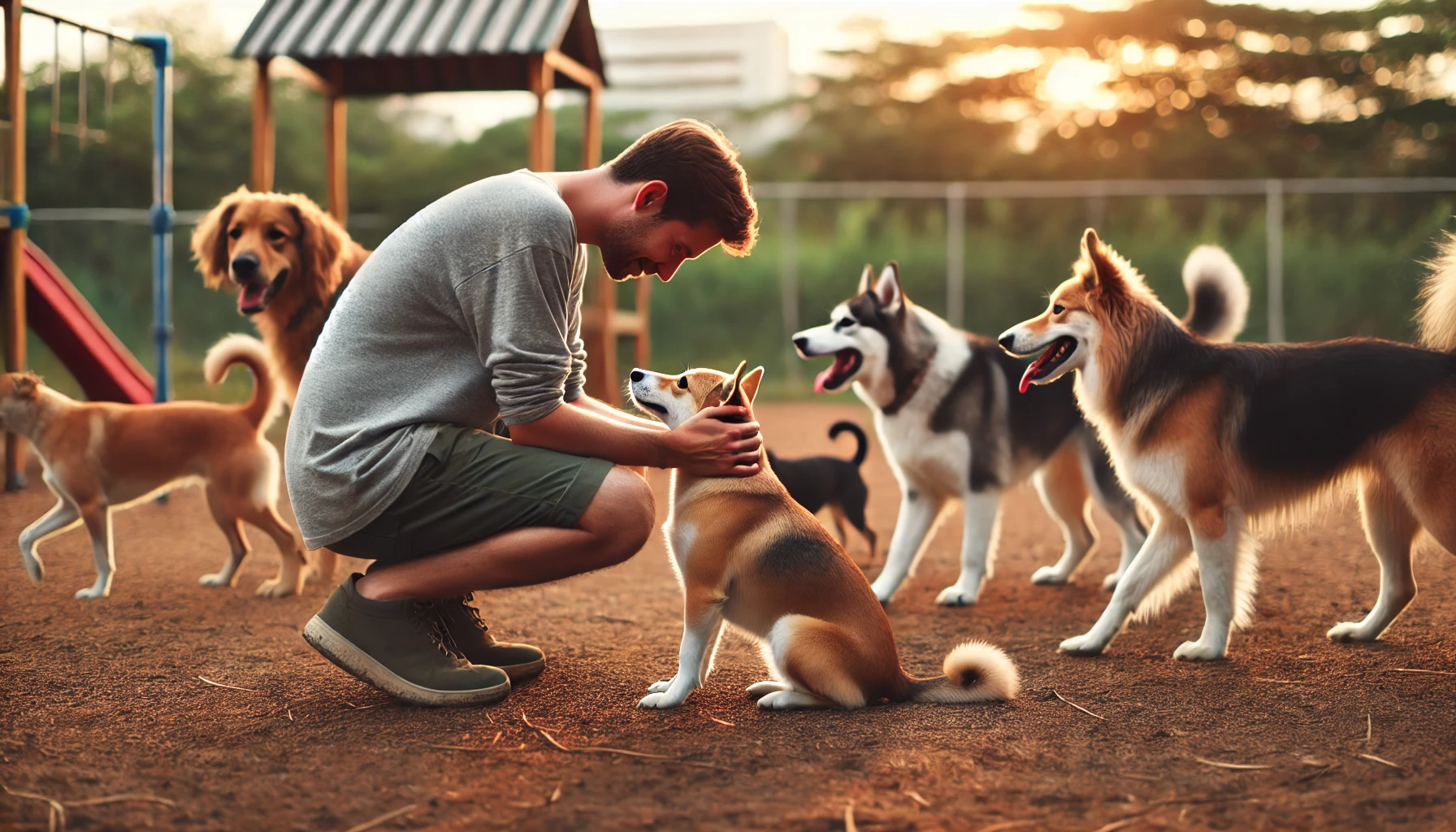Socialization is a crucial aspect of dog training that can significantly affect your dog’s behavior and overall quality of life. For shy or anxious dogs, the process of socialization can be particularly challenging. However, with the right strategies and patience, you can help your shy dog gain confidence and become more comfortable in social settings. This comprehensive guide will walk you through effective techniques and tips for socializing your shy dog, ensuring a positive experience for both of you.
Understanding Dog Socialization
What is Socialization?
Socialization refers to the process of exposing your dog to various environments, people, animals, and experiences in a positive and controlled manner. This exposure helps dogs develop the skills necessary to navigate the world without fear or anxiety.
Why is Socialization Important?
- Reduces Fear and Anxiety: Proper socialization can prevent fear-based behaviors, helping your dog feel more comfortable in unfamiliar situations.
- Promotes Good Behavior: A well-socialized dog is less likely to exhibit problem behaviors such as aggression, excessive barking, or destructiveness.
- Improves Overall Well-Being: Socialization contributes to a happier and healthier dog, enhancing their quality of life and allowing them to enjoy their environment.
The Critical Window for Socialization
The best time to socialize a dog is during their critical developmental period, which occurs between 3 to 14 weeks of age. During this time, puppies are most receptive to new experiences. However, socialization can and should continue throughout a dog’s life, especially for shy or fearful dogs.
Recognizing Shyness in Dogs
Signs of a Shy Dog
Before you can begin socializing your dog, it’s essential to recognize signs of shyness or anxiety. Some common behaviors include:
- Cowering or Hiding: Your dog may seek out a safe space or hide behind you when faced with new people or situations.
- Avoiding Eye Contact: Shy dogs often avoid direct eye contact, which can be a sign of fear or anxiety.
- Tucked Tail: A dog with a tucked tail is usually feeling insecure or scared.
- Low Body Language: A lowered head, ears pinned back, or a stiff posture may indicate discomfort.
- Barking or Growling: Some shy dogs may react by barking or growling when they feel threatened.
Understanding the Root Causes
Shyness in dogs can stem from various factors, including genetics, lack of early socialization, traumatic experiences, or health issues. Understanding your dog’s background can help you tailor your socialization approach.
Preparing for Socialization
Create a Safe Space
Before starting the socialization process, create a safe and comfortable environment for your dog. This space should be free from distractions and loud noises, where your dog can relax and feel secure.
Use Positive Reinforcement
Positive reinforcement is key to successful socialization. Reward your dog with treats, praise, or playtime for calm behavior in new situations. This approach helps create positive associations with social experiences.
Set Realistic Goals
Set achievable goals for your dog’s socialization process. Start with small, manageable steps and gradually increase the complexity of the situations you expose your dog to.
Step-by-Step Guide to Socializing Your Shy Dog
Step 1: Start at Home
Familiarize with Household Members
Begin socialization at home by introducing your dog to different family members. Allow them to approach at their own pace and reward them with treats and praise for positive interactions.
Introduce Household Items
Expose your dog to common household items, such as vacuum cleaners, bicycles, and televisions. Reward them for remaining calm around these items.
Step 2: Gradual Exposure to New Environments
Short Walks in the Neighborhood
Take your dog for short walks around the neighborhood, gradually introducing them to new sights, sounds, and smells. Stay aware of their body language and adjust the distance from potential stressors as needed.
Visit Quiet Parks
Start by visiting quiet parks or less crowded areas. Allow your dog to explore the environment at their own pace, rewarding them for any positive behavior.
Step 3: Controlled Introductions to People and Animals
Introduce One Person at a Time
When introducing your dog to new people, start with one individual at a time. Ask the person to remain calm and avoid direct eye contact. Encourage them to offer treats to your dog, allowing your pet to approach when they feel comfortable.
Gradually Add More People
Once your dog is comfortable with one person, gradually introduce them to more individuals. Maintain a calm and positive atmosphere, rewarding your dog for relaxed behavior.
Step 4: Organize Playdates
Arrange Controlled Playdates
If your dog is comfortable around other dogs, arrange controlled playdates with well-mannered, calm dogs. Choose dogs with similar energy levels to ensure a positive interaction.
Supervise Interactions
Supervise all playdates closely, intervening if your dog shows signs of anxiety or discomfort. Use positive reinforcement to reward calm behavior during interactions.
Step 5: Enroll in Training Classes
Find a Positive Reinforcement Class
Consider enrolling your dog in a training class that uses positive reinforcement techniques. These classes can help your dog learn essential skills while socializing with other dogs and people.
Choose the Right Class
Select a class specifically designed for shy or anxious dogs, where the instructor understands the unique challenges these dogs face.
Step 6: Utilize Desensitization Techniques
Identify Triggers
Identify specific triggers that cause anxiety in your dog, such as loud noises or certain environments.
Gradual Desensitization
Use gradual desensitization techniques by exposing your dog to these triggers at a low intensity. Reward them for remaining calm, gradually increasing the intensity of the exposure over time.
Step 7: Practice Regularly
Consistency is Key
Socialization should be a regular part of your dog’s routine. Consistently expose them to new experiences and environments to reinforce positive behavior.
Vary the Experiences
Vary the types of experiences you introduce, including different people, animals, environments, and sounds. This diversity helps your dog build confidence in various situations.
Step 8: Monitor Progress and Adjust
Track Your Dog’s Behavior
Keep a journal to track your dog’s progress, noting their reactions to new experiences. This will help you identify patterns and adjust your approach as needed.
Be Flexible
Be prepared to adjust your training techniques based on your dog’s comfort level. If a particular experience causes anxiety, take a step back and approach it more gradually.
Dealing with Setbacks
Understanding Setbacks
Setbacks are a normal part of the socialization process, especially for shy dogs. It’s important to remain patient and understanding as your dog learns to navigate the world.
Recognizing Signs of Stress
Be vigilant for signs of stress in your dog, such as panting, pacing, or hiding. If your dog exhibits these behaviors, take a step back and give them time to relax before continuing the socialization process.
Adjusting Your Approach
If a particular situation causes anxiety, consider adjusting your approach. This may involve reducing the intensity of the exposure or changing the environment. Always prioritize your dog’s comfort and well-being.
Building Confidence Through Activities
Engage in Interactive Play
Interactive play can help build your dog’s confidence. Engage in activities such as tug-of-war, fetch, or puzzle toys that stimulate their mind and body.
Explore New Environments Together
Take your dog on adventures to new places, such as hiking trails, beaches, or dog-friendly cafes. Allow them to explore at their own pace while offering positive reinforcement for calm behavior.
Use Training Games
Incorporate training games into your routine to make learning fun and engaging. Games like hide-and-seek, scent work, and obstacle courses can boost your dog’s confidence while enhancing their skills.
Seeking Professional Help
When to Consult a Professional
If your dog’s anxiety or shyness persists despite your efforts, consider seeking help from a professional dog trainer or behaviorist. They can provide tailored advice and support to address your dog’s specific needs.
Finding the Right Professional
Look for trainers or behaviorists who specialize in working with shy or fearful dogs. They should use positive reinforcement techniques and be experienced in dealing with behavioral issues.
Conclusion
Socializing a shy dog requires patience, understanding, and a commitment to positive reinforcement. By following these tips and techniques, you can help your dog build confidence and become more comfortable in social situations. Remember that every dog is unique, and the socialization process may take time. Celebrate your dog’s progress, no matter how small, and continue to provide them with the love and support they need to thrive. With dedication and the right approach, you can transform your shy dog into a confident companion who enjoys exploring the world around them.
Additional Resources
- Books: “The Culture Clash” by Jean Donaldson and “Fear-Free Training for Dogs” by Jason G. S. and P. S. provide valuable insights into dog behavior and training.
- Websites: The American Kennel Club (AKC) and the Association of Professional Dog Trainers (APDT) offer a wealth of information on dog training and socialization.
- Support Groups: Consider joining local dog training clubs or online forums where you can share experiences and seek advice from other dog owners.
By investing time and effort into socializing your shy dog, you can create a happier, healthier, and more confident companion. Remember that the journey of socialization is ongoing, and every step forward is a step towards a more fulfilling life for both you and your dog.

